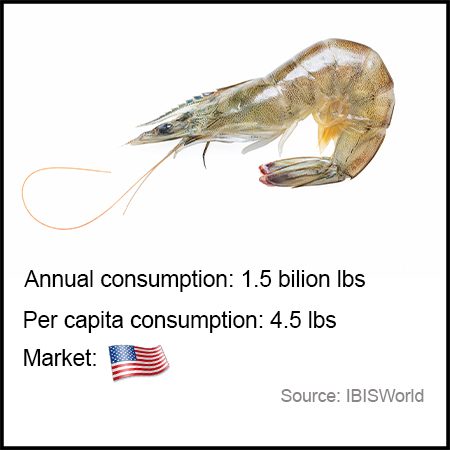STRATEGY
There are many great seafood choices available to consumers today, but we decided to focus on the most popular species with the largest market share: shrimp, specifically Whiteleg shrimp species that holds the largest share of the market.
Here is why:
-
Americans love shrimp, which is by far the most popular seafood in the United States. Shrimp dominate the market by consumption per capita and account together for 25-30 percent of the entire seafood market in the country.
-
With our fast-paced world getting even faster, our goal is to achieve a high capital growth across the entire timeframe we expect to invest for; i.e. short-term or more than one year but less than three years, medium-term or more than three years but less than eight years, and long-term or more than eight years.
Here is how:
-
With shrimp reaching market size in the controlled environment of warm-water RAS in just under four months, we expect each shrimp farm to start generating revenue within the first year of investment.
-
Offering branded, value-added seafood, including the meal kits, through Aquabanq’s seafood e-commerce platform and branching into the food truck industry should ensure both our long-term independence and long-term growth.
-
Additionally, we believe that a deployment of true zero-discharge RAS, which requires only small amounts of water daily and does not need NPDES discharge permits to operate, heralds a paradigm shift in shrimp aquaculture. Instead of the traditional model, where massive farming facilities produce upwards of 5,000 metric tons of shrimp annually in a single location, this zero-discharge technology allows us to build smaller facilities close to market, each with a capacity of up to 1,500 metric tons. This model not only cuts transportation costs in half but also significantly reduces economic, biological, and regulatory risks. It will also eliminate the need to engage with large retailers, minimize logistical overhead, and enable us to match production with local demand. Breaking from the geographic concentration, we have created an expansive roadmap: over 19 shrimp farms stretching from West Virginia to Nevada, Texas to Maine, and many places in between.
In conclusion, we believe that diversifying our income streams both by geography and through distinct distribution channels, including on- and off-trade, will de-risk the investment and make Aquabanq less vulnerable to the factors beyond our control, or where our influence is limited. It will stabilize our cash flow and, most crucially, enable us to remain engaged and stay in touch with our consumers.
Market Opportunity
Aquaculture is currently the fastest-growing form of food production on the planet supplying over 50 percent of the world’s seafood production and that number keeps increasing each year. Consumer perception concerning the nutritional content of fish and seafood is a key determinant of the downstream demand for the industry’s products. In recent years, many consumers have turned toward seafood and away from beef and pork for a variety of health-related reasons. As a result, seafood consumption per capita in the United States is expected to further increase, presenting the industry with a potential opportunity while fueling revenue growth.
The on-trade channel dominates shrimp sales, with Americans allocating 65% of their seafood expenditure in restaurants, which prominently feature shrimp. From 2016 to 2021, shrimp product sales through the on-trade channel surged by 36.6%. The growing popularity can be attributed, at least in part, to the numerous health benefits of shrimp that have encouraged higher consumption in the United States in recent times.
The online channel is expected to be the fastest-growing distribution channel in the on-trade segment. It is projected to register a CAGR value of 12.62% during the forecast period (2022-2028). This growth is due to the increasing number of smartphone users, which increased by 11 million between 2020 and 2021. Around 45% of the population browse online websites through mobile devices. The sales of processed shrimp through online channels increased by 127% during 2016-2021.
Shrimp is the two most popular seafood species in the United States with the largest market shares:
Americans eat a total of 1.5 billion pounds of shrimp a year. That works out
to about 4.5 pounds per person.
to about 4.5 pounds per person.

U.S. is the second largest fish and seafood importer in the world with a small and fractured aquaculture industry, with no major domestic players, and a lot of room to grow:

